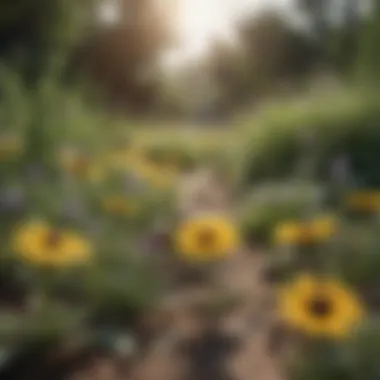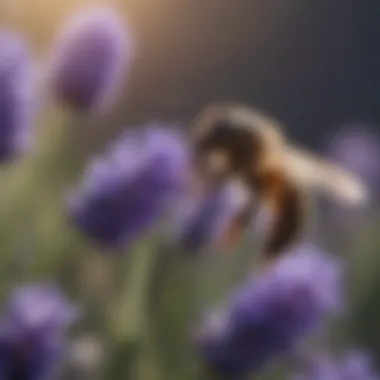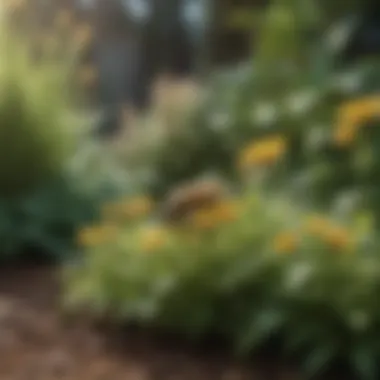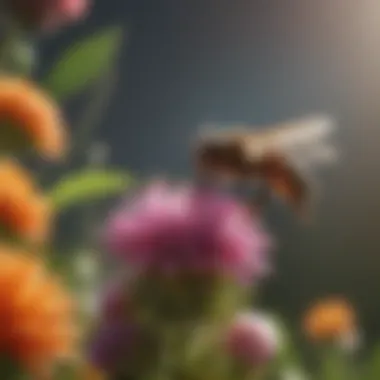The Floral Favorites of Bees: A Comprehensive Guide


Intro
Bees are not just buzzing insects; they play a critical role in our ecosystem. Their choices of flowers influence not only their survival but also the health of the environment. Understanding which floral options attract these important pollinators is essential for gardeners and anyone interested in fostering a more environmentally friendly space. This article delves into the floral preferences of bees and offers insights into how to create a garden that supports their needs while enhancing the ecological balance.
Key Points of Discussion
In exploring the preferred flowers of bees, we will cover several important topics. First, we will identify specific flower types that bees favor. Then we will examine their botanical characteristics and why those traits are appealing. Finally, we will discuss the ecological significance of planting bee-friendly gardens. This comprehensive approach aims to inform and encourage gardening practices that promote environmental sustainability.
The Importance of Bee-Friendly Plants
Choosing the right plants is crucial. Different species of bees are attracted to different types of flowers based on various factors. Color, shape, and scent of flowers all play a role in attraction. By understanding these preferences, gardeners can better cater to bee populations. Additionally, planting a variety of flowers ensures that bees have access to food sources throughout the growing season.
One should also take into account that many flowers that are most beneficial to bees bloom at various times. For example, early bloomers like crocuses awaken in spring, providing vital resources after the winter. Meanwhile, late bloomers like asters keep providing nourishment for bees as they prepare for winter.
The presence of diverse floral species in a garden bolsters bee populations and enhances biodiversity overall.
In summary, this article will unravel not just the flowers that bees prefer, but also the connections between plants and bees. These insights can lead to actionable practices for improving gardening and promoting ecosystem health.
Intro to the Importance of Bees
Bees play a crucial role in maintaining ecological balance. Their impact extends beyond the production of honey. They are essential pollinators, facilitating the reproduction of many flowering plants. Without bees, the diversity of plant life would decline significantly. This decline would affect food sources for various animal species, including humans.
One of the primary benefits of bees is their contribution to agriculture. Many crops rely on bee pollination to produce fruits and seeds. It is estimated that one-third of food consumed globally depends on pollinators, especially bees. Therefore, understanding the preferred floral choices of bees can profoundly influence gardening practices and agricultural productivity.
In addition to their agricultural value, bees also help sustain wild plant populations. This in turn supports broader ecosystems. The decline of bee populations can lead to reduced plant diversity, which disrupts habitats for birds and other wildlife.
Furthermore, bees are indicators of environmental health. Their presence or absence can signal the well-being of various ecosystems. Thus, promoting bee-friendly practices can serve as a measure of ecological stewardship.
The importance of this topic cannot be understated. As pet owners and gardening enthusiasts, understanding how to attract and support bee populations can lead to healthier gardens and sustainable ecosystems. By choosing the right flowers and adopting mindful gardening habits, we can play an active role in conserving bee populations and, by extension, our environment.
"Understanding the needs of bees is a step toward broader ecological awareness and responsibility."
Through this article, readers will explore the specific floral choices that attract bees, how flowers engage with these pollinators, and the characteristics that make certain plants stand out. All these insights can enrich gardening practices, fostering a vibrant and sustainable relationship between humans and the natural world.
Understanding Pollination
Pollination is a critical process that nurtures the relationship between bees and flowers. It is through this interaction that bees facilitate the reproduction of flowering plants. As bees move from one bloom to another seeking nectar, they unintentionally transfer pollen from the male part of a flower to the female part. This process leads to fertilization, enabling the plant to produce seeds and reproduce.
The benefits of pollination extend far beyond the mere survival of plants. Approximately 75% of global food crops depend on pollinators, primarily bees. This includes essential fruits, vegetables, and nuts that are vital for human diets. Therefore, understanding pollination is not just an academic exercise; it highlights the intricate balance of ecosystems and our dependence on these small creatures.
Moreover, pollination promotes biodiversity. It ensures the genetic diversity of plants, which is crucial in maintaining stable ecosystems. Different species of flowers attract various bees, creating a network of interactions that fosters a vibrant environment.
In addition, the concern regarding pollinator decline makes the study of pollination increasingly relevant. As habitats change and pesticides are used more widely, understanding pollination and its significance can inform better gardening practices and environmental policies.
By grasping the fundamentals of pollination, we can foster better habits to protect bee populations and, subsequently, support our ecosystems.
Role of Bees in Ecosystems
Bees play an irreplaceable role in maintaining the health of our ecosystems. They are often recognized as the most effective pollinators. Various bee species, such as honeybees, bumblebees, and solitary bees, contribute significantly to this process. Their ability to transfer pollen efficiently leads to fruitful plants, which in turn support a myriad of other life forms.
The relationship between bees and flowers is mutually beneficial. While bees gather nectar for sustenance, they help flowers reproduce, thus ensuring the growth of the flora upon which other species depend. This interaction contributes to the stability of food webs, ultimately sustaining wildlife populations and human activities alike.
Furthermore, studies have shown that diverse bee populations enhance both fruit quality and yield. When different bee species are present, they ensure that a broad range of plants get pollinated, which boosts ecosystem resilience.
In summary, bees do much more than produce honey. Their role as pollinators underscores their importance in promoting biodiversity, sustaining agriculture, and maintaining the health of the planet.


How Flowers Attract Bees
Flowers have evolved various strategies to attract bees. Their allure is not just about aesthetics; it’s about survival and reproductive success. Bees are drawn to certain visual and olfactory cues that indicate a flower's viability as a food source.
- Color Preferences: Bees are particularly responsive to bright colors, especially blue, purple, and yellow. They can see ultraviolet light, which many flowers reflect, helping them locate blooms more efficiently.
- Fragrance: Scent plays a crucial role in attracting bees. Flowers release volatile compounds that serve as alluring fragrances, signaling their presence. These aromas can be strong or faint, depending on the species.
- Nectar Availability: Of course, the most alluring feature for bees is nectar. Flowers that produce abundant and high-quality nectar are preferred by bees. This not only signifies a food source but also promises a rewarding visit for the bees.
- Structural Adaptations: The shape of a flower can influence bee access. Some flowers are tailored specifically for certain bee species, ensuring that only the most efficient pollinators can access their nectar and pollen.
By understanding how flowers attract bees, gardeners can cultivate bee-friendly environments. This knowledge can inform their choices about which plants to integrate into their gardens, thereby fostering a healthier ecosystem.
Characteristics of Bee-Friendly Flowers
The selection of flowers that attract bees is not arbitrary; there are specific characteristics that make certain plants more appealing to them. Understanding these traits is crucial for anyone interested in cultivating a garden that supports bee populations. Bee-friendly flowers serve not just aesthetic purposes, but also ecological ones. By prioritizing these characteristics, gardeners can create habitats that offer sustenance and refuge for bees, while also contributing to the overall health of the environment.
Color Preferences
Bees are innately attracted to specific colors. Their vision differs from humans, allowing them to see ultraviolet light, which most flowers reflect. This unique capacity influences their choices.
- Bluish and Purple Tones: Flowers that exhibit blue and purple shades are particularly appealing to bees. Examples include lavender and bluebells.
- Yellow: Brightly colored flowers, such as sunflowers and dandelions, also capture their interest.
- UV Patterns: Many blooms display patterns that are visible in ultraviolet light, guiding bees to nectar and pollen.
The presence of these colors in the garden can significantly increase bee visitation and ensure effective pollination.
Fragrance and Nectar Production
The aroma of flowers plays a significant role in attracting bees. Many species produce distinctive scents, which can influence foraging behavior. The production of nectar is equally critical, as it satiates the bees' dietary needs.
- Scent: A strong fragrance can enhance a flower's attractiveness. Plants like bee balm are known for their enticing scents that lure in bees.
- Nectar Quality: High sugar concentration in nectar encourages bees to return to the same flower. For instance, honeybee-friendly flowers tend to have ample nectar production.
- Nectar Guides: Some flowers possess markings that signal the presence of nectar, making it easier for bees to locate food sources.
By selecting flowers with desirable scents and nectar, gardeners can optimize the pollination process and support bee health.
Shape and Structure
The physical attributes of flowers significantly impact their accessibility to bee species. The shape and structure must allow for easy entry for foraging practices.
- Open Structures: Flowers that have open, accessible shapes like aster and daisy enable bees to efficiently collect pollen.
- Tubular Shapes: While some bees can access tubular flowers, not all species can navigate these designs, which may restrict which bees can feed on them. Plants such as honeysuckle are examples.
- Blooming Cycle: A staggered blooming period ensures that during various seasons, bees have a consistent food source.
Incorporating flowers with various shapes and sizes in the garden can support diverse bee populations and enhance biodiversity.
Providing a variety of colors, fragrances, and structures in the garden helps to establish an environment conducive to bee health and activity.
Top Flowers for Bees
The selection of flowers that attract bees plays a crucial role in creating a healthy ecosystem. Understanding which flowers are favored by bees can enhance gardening practices for pet owners and animal lovers alike. By specifically choosing bee-friendly flowers, one can support local bee populations, promote biodiversity, and contribute to environmental stability. Flowers that appeal to bees also produce healthier gardens and yield improved fruit and vegetable harvests.
Lavender
Lavender is widely recognized as a top pick for bees. Its vibrant purple flowers are visually appealing and are known for their rich nectar content. Bees are attracted to the strong scent of lavender, which makes it an ideal choice for any garden. This plant thrives in well-drained soil and requires ample sunlight to grow. Plus, lavender is drought-resistant, making it a sustainable option.
Benefits:
- Attracts a variety of bee species.
- Provides long-flowering seasons.
When planting lavender, consider spacing the plants adequately to allow for bee movement. This not only supports pollinators but also encourages a lush growth of lavender that can enhance beauty in gardens.
Sunflowers
Sunflowers, with their tall stalks and large heads, serve as a significant resource for bees. These bright flowers produce ample nectar and pollen that bees require. Sunflowers are also easy to grow and quickly grab attention in any garden layout.


Benefits:
- Sunflowers attract multiple bee species simultaneously.
- They can reach heights that make them prominent in a garden.
Planting sunflowers provides an exciting opportunity to observe pollinators. Their cheerful disposition and easy maintenance make them excellent for both experienced gardeners and beginners alike.
Coneflower
Coneflower, or Echinacea, is another favored flower among bees. The unique structure of its petals encourages bees to gather nectar. With a sturdy stem, coneflowers can support themselves in various weather conditions. They are also perennial, meaning they will return annually, offering consistent food sources.
Benefits:
- They attract butterflies and other beneficial insects too.
- Coneflowers are drought-resistant and low-maintenance.
Incorporating coneflowers into the garden is a smart choice, providing beauty while supporting local ecology effectively.
Bee Balm
Bee balm, or Monarda, is aptly named for its ability to attract bees. Its tubular flowers are designed for efficient nectar access, appealing mainly to honeybees. This plant also provides a splash of color, with varieties ranging from deep reds to soft purples.
Benefits:
- It has aromatic foliage and can be used in herbal teas.
- Bee balm draws in hummingbirds as well.
Planting bee balm can boost biodiversity within your garden, creating an ecosystem that gives back to pollinators and offers enjoyment through its vibrant blooms.
Wildflowers
Wildflowers are a collective choice that provides a multitude of benefits. They enrich the habitats of insects and offer varied ecological support. With numerous types available, wildflowers can complement existing plants in a garden, creating a natural aesthetic.
Benefits:
- They're low-maintenance and often self-seeding.
- They create a diverse food source for many species, not just bees.
Establishing a section of wildflowers is a simple yet effective way to cultivate an inviting environment for bees, ensuring their presence while enhancing the garden’s appeal.
In summary, incorporating these top flowers such as lavender, sunflowers, coneflowers, bee balm, and wildflowers will substantially contribute to attracting bees. Through thoughtful selection, one can foster a nurturing space for these vital pollinators.
Planting Practices to Attract Bees
Bees play a critical role in pollination and maintaining healthy ecosystems. Yet, the choices we make in our gardens can significantly influence the wellbeing of these vital creatures. Understanding planting practices can transform standard gardens into bee-friendly environments. By selecting appropriate plants, creating diversity, and ensuring year-round support, garden enthusiasts can encourage bee populations. These practices deliver benefits not only to bees but also to overall garden health.
Native Plants vs.
Non-Native Plants
Selecting native plants is essential for creating a welcoming environment for bees. Native flora evolved alongside local bee species, leading to mutual adaptions that enhance pollination efficiency. These plants typically require less maintenance and resources, as they are better suited to the local climate and soil conditions. Examples of native plants include purple cone flowers and black-eyed Susans.
In contrast, non-native plants may not provide the same ecological support. While they can be attractive and colorful, many do not offer sufficient nectar or pollen. Moreover, non-native species often require more water and fertilizers, which can result in environmental strain. However, some non-native plants can also provide benefits. It is important to research and select non-native species that are known to be bee-friendly, such as lavender.
Creating a Diverse Garden
Diversity is key in planting practices that attract bees. A varied selection of flora ensures that bees find food throughout their active seasons. Different flowers bloom at different times, providing consistent nectar sources. For instance, a mix of early spring bloomers like crocus and late summer options such as asters keeps bees nourished.
When planning a garden, choose flowers of various shapes, sizes, and colors. This diversity not only attracts a wider range of bee species but also enhances the visual appeal of the garden. Additionally, incorporating plants of varying heights creates layers that offer shelter and nesting sites for bees.


- Select flowers that bloom at various times of the year.
- Include a mix of native and well-researched non-native plants.
- Utilize different flower shapes to accommodate diverse bee types.
Seasonal Planting for Year-Round Support
Planning for seasonal planting is critical to providing continuous support for bee populations. A well-timed planting schedule can improve the availability of resources for bees, promoting a healthy ecosystem. Early spring bloomers are essential as they serve as a food source after winter.
Considerations for seasonal planting include:
- Early Spring: Crocus, snowdrops, and hellebores.
- Summer: Features like bee balm, lavender, and sunflowers.
- Fall: Asters, goldenrods, and sedums continue to support bees as they prepare for winter.
By embracing seasonal diversity, you establish a garden that can sustain bee populations year-round, ensuring they flourish in both health and numbers.
In summary, strategic planting practices are crucial in aligning gardening goals with environmental sustainability.
Implementing these practices will enhance your garden while playing a part in preserving vital bee populations. From choosing the right plants to ensuring year-round support, these approaches offer meaningful progress towards a healthier ecosystem.
Maintaining a Bee-Friendly Environment
Maintaining a bee-friendly environment is crucial for the health and longevity of bee populations. Bees are essential for pollination, which supports biodiversity and food production. Without a conducive habitat, bees struggle to survive. Creating an environment that supports these important insects involves several key factors.
Avoiding Pesticides
One major consideration in maintaining a bee-friendly environment is the avoidance of pesticides. Many gardeners rely on chemical treatments to control pests, often without realizing the harm they can inflict on bee populations. Pesticides, particularly neonicotinoids, are known to disrupt bee behavior, reduce reproductive success, and even cause death in bees.
To protect bees:
- Opt for organic gardening practices whenever possible.
- Use natural pest control methods, such as introducing beneficial insects or using barriers to keep pests away.
- If pesticides must be used, choose the least toxic options and apply them in the evening when bees are less active.
By reducing pesticide use, you not only benefit bees but also promote overall ecosystem health.
Providing Water Sources
Another essential element for maintaining a bee-friendly environment is the provision of accessible water sources. Bees need water to hydrate and often collect it for their hives. A simple way to help is by creating shallow water dishes in your garden. These can be filled with pebbles or marbles to give bees a safe place to land while drinking.
To create effective water sources, consider these tips:
- Use wide, shallow containers.
- Change the water frequently to prevent algae growth.
- Place the containers in sunny spots to attract bees.
A reliable water source can significantly enhance the working conditions for bees, allowing them to thrive and continue their important role in pollination.
A bee-friendly environment is not just beneficial for bees; it fosters a diverse ecosystem, ultimately leading to a healthier garden and a more vibrant community.
Ending
The exploration of the preferred floral choices of bees is not merely an academic pursuit; it has significant real-world implications for the environment and our gardening practices. Understanding which flowers attract bees effectively helps us promote biodiversity and sustain essential pollinator populations.
Choosing the right flowers can create a thriving ecosystem within your garden. Bee-friendly plants not only provide the required nectar and pollen but also enhance the aesthetic value of the landscape. Native plants, for instance, have evolved alongside local bee species, making them ideal for fostering healthy interactions.
Here are some critical elements to consider:
- Selection of Flowers: Choose a variety of blooms that provide resources throughout the growing season. This will attract different bee species and ensure that pollinators have access to food all year round.
- Plant Positioning: Strategically placing the flowers in sunny spots can make a noticeable difference. Bees are drawn to warmth and light, so consider their placement carefully.
- Avoiding Chemicals: As mentioned in the article, avoiding pesticides is crucial. Chemicals can harm bees and reduce their foraging abilities, so a chemical-free gardening approach is highly recommended.
Benefits to Consider:
- Increased biodiversity in your garden can lead to an improvement in the overall health of your local ecosystem.
- A bee-friendly garden can contribute to the increased yield of fruits and vegetables due to effective pollination.
In summary, implementing practices that support bee populations reflects an understanding of the intricate relationship between plants and pollinators. It enhances not only our gardens but also the greater ecological balance. By making informed choices, such as selecting suitable flowers and adopting sustainable practices, we can contribute to the health of bee populations and support essential pollination services.
"Bees are vital for our ecosystems and food production, and their decline demands our urgent attention and action."
Understanding bees and their floral preferences goes beyond aesthetics; it is a step towards conserving important species and ensuring that our environment thrives.







